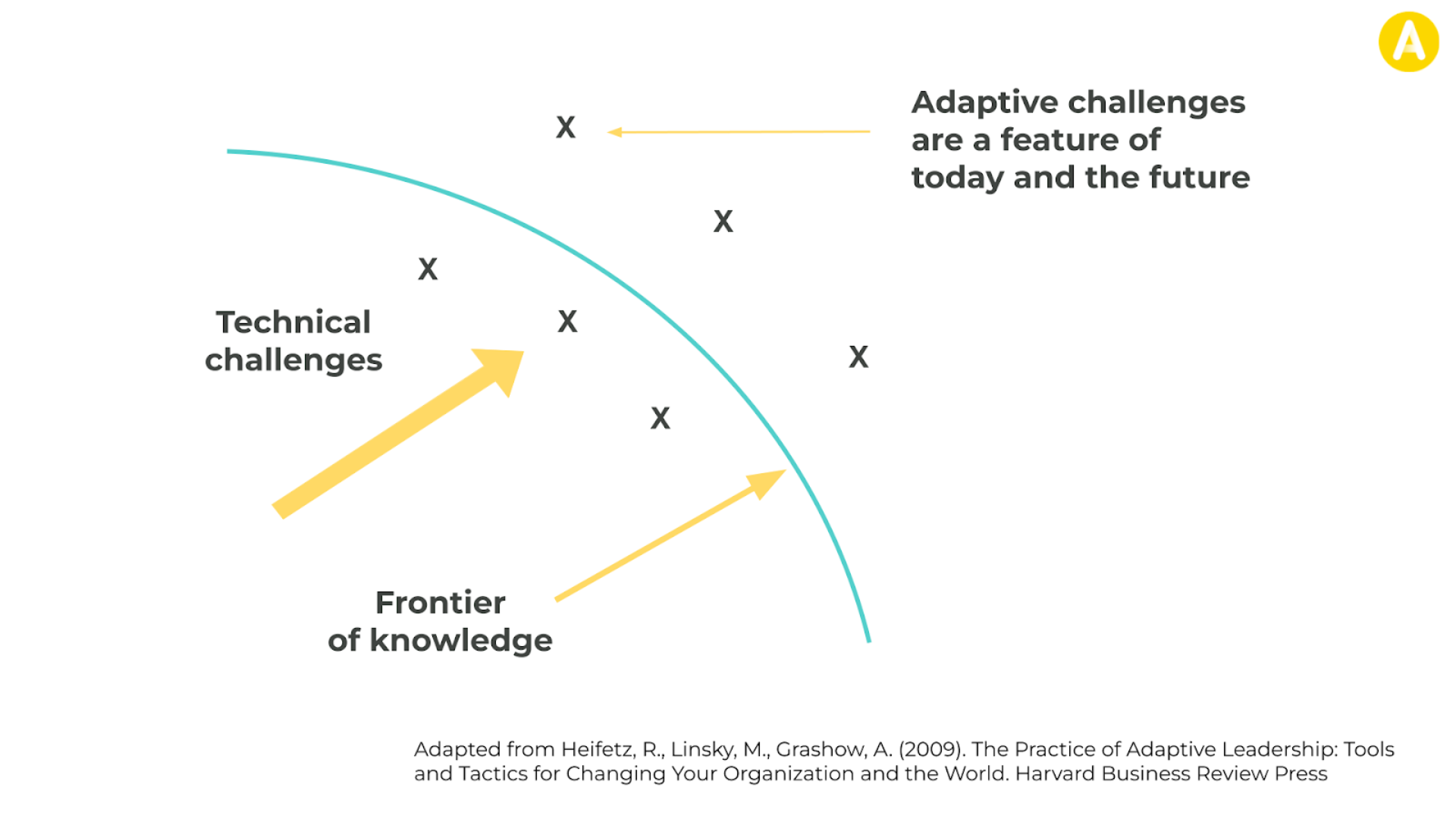
When my wife Emma and I started out in consulting two decades ago, we were helping organizations come up with solutions for the big, gnarly problems they were facing.
We loved it and quickly gained momentum. A good friend Tim also joined the business and we did some fun, impactful work together – or so we thought. The feedback from clients was that the strategies we helped them create were “bang on”. I thought many of the resulting plans were works of art!
The crunch came when we started visiting these organizations six months later to check in… and, for many of them, very little had changed.
So what went wrong? We hadn’t fallen into the consulting trap of doing all the work for our clients – these strategies were co-created, based on current issues, and informed by current capabilities. A little digging revealed the core issue. The work to be done wasn’t developing a plan or strategy. It was developing leadership. In the complex, dynamic world we live in, no matter how good a plan is, it’s almost always irrelevant after the first action is taken. The situation changes, someone has an unexpected reaction, or what you thought would work doesn’t. When this happens, you’re left without a plan but with your leadership: or more importantly your leadership mindset.
The teams we worked with that did make progress had something in common: they had the belief and mindset to be proactive, to experiment and to learn… and they were off to the races.
Looking back, that experience taught us a lot. It inspired Em and I to move into leadership development and informed the approach we still use today. Instead of coming in as ‘experts’, ready to provide solutions with detailed plans, we support leaders to experimentally and iteratively address the challenges they face (which we now see are predominately ‘adaptive’) – and in the process support them to develop ever more proactive, aware, and flexible mindsets.
Humans have always faced complex, adaptive challenges, but these kinds of challenges are front and center today with the profound changes happening in our world.
Adaptive vs technical challenges
There’s a saying my dad would often repeat when I was a kid, ‘Horses for courses’. This is a great metaphor for effective leadership: different types of challenges need different leadership approaches.
Professor Ron Heifetz – a leading thinker in adaptive leadership – distinguishes between Technical and Adaptive challenges, and has a helpful framework for diagnosing new challenges you come up against:
- Technical challenges are clear-cut and have been dealt with before. You can solve them with the right expertise or best practice. If it’s possible to teach someone how to tackle a challenge then it’s a technical one.
- Adaptive challenges are new and complex, often involving ‘blurry’ causes and effects and stakeholder groups with competing interests. They may require stakeholders to make changes to their beliefs, habits and even identity. There are no existing solutions: if an expert tells you they’ve got the magic answer, they’re likely part of the problem.

In reality, most challenges are a mix of both. Breaking these down and applying the right approach to each part can avoid a lot of headaches and waste. Many of our early consulting attempts were clearly technical approaches for adaptive challenges.
Leading through technical challenges is straightforward – though not always easy. Find the best practice, expert or AI tool and get to work.
With adaptive challenges, there are no best-practices. So what can you do when training people, ‘calling in the experts’, or even the boss won’t get you a solution?
Mindset growth is key
While expertise and authority bounce off adaptive challenges, growing leadership mindsets takes a sledge hammer to them.
In my article Growing Adaptive Mindsets Part 1, I shared how developing awareness of your own and others’ mindsets is essential in leadership. This is especially true for leading through adaptive challenges, where we need to have the flexibility to see different perspectives (rather than just seeing them as we want them to be).
To quickly summarize part 1, our mindsets are shaped by our past experiences. Each experience imprints a view of how to solve a challenge – i.e. doing what worked in the past – which can obscure the real work to be done.
At Adeption, we find the lens of vertical development useful for understanding how different people make sense of the world. This categorizes how people (adults) think into a range of mindsets, which also provides a model for leader mindset development.
Take a simple example of declining sales growth for a product. A leader may look at the situation and think:
- “We need to improve the product quality.” (an Expert mindset).
- “We need better sales processes and goals.” (Achiever).
- “Are we still relevant? We need to look at our strategy.” (Redefining).
- “It’s time to change how pricing models work in the market.” (Transforming mindset).
In the scenario above, any of these approaches could be right. With adaptive challenges, it’s most likely all are required and should be considered and experimented with.
Having awareness of and trying on different mindsets is the first step to ‘seeing’ more factors and possibilities. Often simply making people aware of the mindsets they have in their ‘range’ (through an assessment) can help operate in a more flexible way. The second is to help them grow their range, as it can be hard to ‘see’ through mindsets you don’t yet have. This mindset work is huge because it gives leaders choices instead of defaulting to a single way of thinking.
Leading through adaptive challenges
To lead through adaptive challenges effectively, you need to get comfortable operating in the ‘grey’ and experimenting. Solving these challenges usually means disrupting the status quo, which can involve types of ‘loss’ and lead to resistance. Part of adaptive leadership is holding space for people and involving them in the process.
Thankfully, you don’t have to lead through these challenges without a compass. Leading in an adaptive way involves the very same approach that grows your mindset range and leadership capacity. At Adeption, we’ve summarized and practiced this with hundreds of thousands of leaders with our B3 methodology – a process in which you constantly:
- Be Conscious of what currently matters, what’s working and what isn’t
- Be Curious about what other views and approaches could exist
- Be Better through experimentation and deliberate reflection on results
The exciting thing is, we’re seeing Adeption programs lead to measurable mindset growth in leaders in a matter of months.
Some specific rules of thumb for applying B3 to to adaptive challenges are:
- Get on the balcony: Step back to get a broad, strategic view of the situation including the dynamics at play, root causes, and any patterns.
- Collaborate: With adaptive challenges, no one person has all the answers, and challenges often sit in the ‘cracks’ of organizational structures. Getting to solutions takes collaboration: enlist and motivate others.
- Experiment: Learn by running lots of small experiments or creating fast prototypes. As well as helping get to solutions, experiments can help you understand the situation better.
- Reflect and continuously learn: Reflection helps you learn from the results of experiments, refine and iterate your approach, and gain insights.
Great leadership is forged in challenging times
To wrap up, it’s true our world is rapidly changing and adaptive challenges are coming at us fast. It’s also true that leading in this complexity isn’t easy…
However there’s some good news. This very environment that demands so much of us provides the exact conditions needed to develop our mindsets and leadership capacity. The feedback loop is positive. The iterative experiments that help us progress adaptive challenges are the best way to develop a wider range of leadership mindsets, to help us ‘see’ the things these challenges require!
Finally, of course this isn’t a new idea. History shows the best leadership, innovation and development often happens on the edge of certainty and comfort. In fact, this is at the very core of how humans are wired to learn and adapt.
